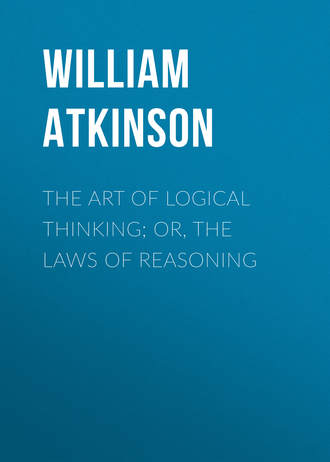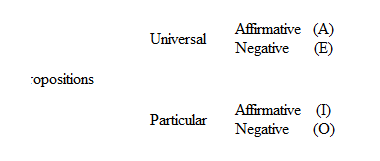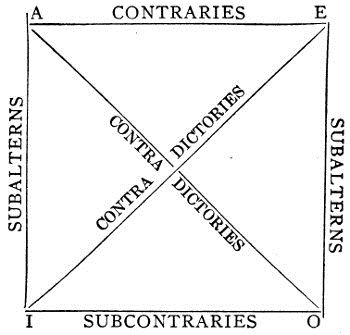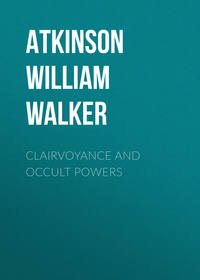 полная версия
полная версияThe Art of Logical Thinking; Or, The Laws of Reasoning
Crabbe discriminates between a Definition and an Explanation, as follows: "A definition is correct or precise; an explanation is general or ample. The definition of a word defines or limits the extent of its signification; it is the rule for the scholar in the use of any word; the explanation of a word may include both definition and illustration; the former admits of no more words than will include the leading features in the meaning of any term; the latter admits of an unlimited scope for diffuseness on the part of the explainer."
Hyslop gives the following excellent explanation of the Logical Definition, which as he states is the proper meaning of the term in Logic. He states:
"The rules which regulate Logical Definition are as follows:
1. A definition should state the essential attributes of the species defined.
2. A definition must not contain the name of word defined. Otherwise the definition is called a circulus in definiendo.
3. The definition must be exactly equivalent to the species defined.
4. A definition should not be expressed in obscure, figurative, or ambiguous language.
5. A definition must not be negative when it can be affirmative."
A correct definition necessarily requires the manifestation of the two respective processes of Analysis and Synthesis.
Analysis is a term denoting: "The separation of anything into its constituent elements, qualities, properties and attributes." It is seen at once that in order to correctly define an object, person or thing, it is first necessary to analyze the latter in order to perceive its essential and accidental properties or differences. Unless the qualities, properties and attributes are clearly and fully perceived, we cannot properly define the object itself.
Synthesis is a term denoting: "The act of joining or putting two or more things together; in Logic: the method by composition, in opposition to the method of resolution or analysis." In stating a definition we must necessarily join together the various essential qualities, properties and attributes, which we have discovered by the process of analysis; and the synthesized combination, considered as a whole, is the definition of the object expressed by the term.
CHAPTER VIII.
JUDGMENTS
The first step in the process of reasoning is that of Conception or the forming of Concepts. The second step is that of Judgment, or the process of perceiving the agreement or disagreement of two conceptions.
Judgment in Logic is defined as: "The comparing together in the mind of two notions, concepts or ideas, which are the objects of apprehension, whether complex or incomplex, and pronouncing that they agree or disagree with each other, or that one of them belongs or does not belong to the other. Judgment is therefore affirmative or negative."
When we have in our mind two concepts, we are likely to compare them one with the other, and to thus arrive at a conclusion regarding their agreement or disagreement. This process of comparison and decision is what, in Logic, is called Judgment.
In every act of Judgment there must be at least two concepts to be examined and compared. This comparison must lead to a Judgment regarding their agreement or disagreement. For instance, we have the two concepts, horse and animal. We examine and compare the two concepts, and find that there is an agreement between them. We find that the concept horse is included in the higher concept of animal and therefore, we assert that: "The horse is an animal." This is a statement of agreement and is, therefore, a Positive Judgment. We then compare the concepts horse and cow and find a disagreement between them, which we express in the statement of the Judgment that: "The horse is not a cow." This Judgment, stating a disagreement is what is called a Negative Judgment.
In the above illustration of the comparison between the concepts horse and animal we find that the second concept animal is broader than the first, horse, so broad in fact that it includes the latter. The terms are not equal, for we cannot say, in truth, that "an animal is the horse." We may, however, include a part of the broader conception with the narrower and say: "some animals are horses." Sometimes both concepts are of equal rank, as when we state that: "Man is a rational animal."
In the process of Judgment there is always the necessity of the choice between the Positive and the Negative. When we compare the concepts horse and animal, we must of necessity decide either that the horse is an animal, or else that it is not an animal.
The importance of the process of Judgment is ably stated by Halleck, as follows: "Were isolated concepts possible, they would be of very little use. Isolated facts are of no more service than unspun wool. We might have a concept of a certain class of three-leaved ivy, as we might also of poisons. Unless judgment linked these two concepts and decided that this species of ivy is poisonous, we might take hold of it and be poisoned. We might have a concept of bread and also one of meat, fruit and vegetables. If we also had a concept of food, unrelated to these, we should starve to death, for we should not think of them as foods. A vessel, supposing itself to be far out at sea, signaled another vessel that the crew were dying of thirst. That crew certainly had a concept of drinkable things and also of water. To the surprise of the first, the second vessel signaled back, 'Draw from the sea and drink. You are at the mouth of the Amazon.' The thirsty crew had not joined the concept drinkable to the concept of water over the ship's side. A man having taken an overdose of laudanum, his wife lost much valuable time in sending out for antidotes, because certain of her concepts had not been connected by judgment. She had good concepts of coffee and of mustard; she also knew that an antidote to opium was needed; but she had never linked these concepts and judged that coffee and mustard were antidotes to opium. The moment she formed that judgment she was a wiser woman for her knowledge was related and usable… Judgment is the power revolutionizing the world. The revolution is slow because nature's forces are so complex, so hard to be reduced to their simplest forms and so disguised and neutralized by the presence of other forces… Fortunately judgment is ever silently working and comparing things that, to past ages, have seemed dissimilar; and it is continually abstracting and leaving out of the field of view those qualities which have simply served to obscure the point at issue."
Judgment may be both analytic or synthetic in its processes; and it may be neither. When we compare a narrow concept with a broader one, as a part with a whole, the process is synthetic or an act of combination. When we compare a part of a concept with another concept, the process is analytic. When we compare concepts equal in rank or extent, the process is neither synthetic nor analytic. Thus in the statement that: "A horse is an animal," the judgment is synthetic; in the statement that: "some animals are horses," the judgement is analytic; in the statement that: "a man is a rational animal," the judgment is neither analytic nor synthetic.
Brooks says: "In one sense all judgments are synthetic. A judgment consists of the union of two ideas and this uniting is a process of synthesis. This, however, is a superficial view of the process. Such a synthesis is a mere mechanical synthesis; below this is a thought-process which is sometimes analytic, sometimes synthetic and sometimes neither analytic nor synthetic."
The same authority states: "The act of mind described is what is known as logical judgment. Strictly speaking, however, every intelligent act of the mind is accompanied with a judgment. To know is to discriminate and, therefore, to judge. Every sensation or cognition involves a knowledge and so a judgment that it exists. The mind cannot think at all without judging; to think is to judge. Even in forming the notions which judgment compares, the mind judges. Every notion or concept implies a previous act of judgment to form it: in forming a concept, we compare the common attributes before we unite them; and comparison is judgment. It is thus true that 'Every concept is a contracted judgment; every judgment an expanded concept.' This kind of judgment, by which we affirm the existence of states of consciousness, discriminate qualities, distinguish percepts and form concepts, is called primitive or psychological judgment."
In Logical Judgment there are two aspects; i. e., Judgment by Extension and Judgment by Intension. When we compare the two concepts horse and animal we find that the concept horse is contained in the concept animal and the judgment that "a horse is an animal" may be considered as a Judgment by Extension. In the same comparison we see that the concept horse contains the quality of animality, and in attributing this quality to the horse, we may also say "the horse is an animal," which judgment may be considered as a Judgment by Intension. Brooks says: "Both views of Judgment are correct; the mind may reach its judgment either by extension or by intension. The method by extension is usually the more natural."
When a Judgment is expressed in words it is called a Proposition. There is some confusion regarding the two terms, some holding that a Judgment and a proposition are identical, and that the term "proposition" may be properly used to indicate the judgment itself. But the authorities who seek for clearness of expression and thought now generally hold that: "A Proposition is a Judgment expressed in words." In the next chapter, in which we consider Propositions, we shall enter into a more extended consideration of the subject of Judgments as expressed in Propositions, which consideration we omit at this point in order to avoid repetition. Just as the respective subjects of Concepts and Terms necessarily blend into each other, so do the respective subjects of Judgments and Propositions. In each case, too, there is the element of the mental process on the one hand and the verbal expression of it on the other hand. It will be well to keep this fact in mind.
CHAPTER IX.
PROPOSITIONS
We have seen that the first step of Deductive Reasoning is that which we call Concepts. The second step is that which we call Propositions.
In Logic, a Proposition is: "A sentence, or part of a sentence, affirming or denying a connection between the terms; limited to express assertions rather than extended to questions and commands." Hyslop defines a Proposition as: "any affirmation or denial of an agreement between two conceptions."
Examples of Propositions are found in the following sentences: "The rose is a flower;" "a horse is an animal;" "Chicago is a city;" all of which are affirmations of agreement between the two terms involved; also in: "A horse is not a zebra;" "pinks are not roses;" "the whale is not a fish;" etc., which are denials of agreement between the terms.
The Parts of a Proposition are: (1) the Subject, or that of which something is affirmed or denied; (2) the Predicate, or the something which is affirmed or denied regarding the Subject; and (3) the Copula, or the verb serving as a link between the Subject and the Predicate.
In the Proposition: "Man is an animal," the term man is the Subject; the term an animal is the Predicate; and the word is, is the Copula. The Copula is always some form of the verb to be, in the present tense indicative, in an affirmative Proposition; and the same with the negative particle affixed, in a negative Proposition. The Copula is not always directly expressed by the word is or is not, etc., but is instead expressed in some phrase which implies them. For instance, we say "he runs," which implies "he is running." In the same way, it may appear at times as if the Predicate was missing, as in: "God is," by which is meant "God is existing." In some cases, the Proposition is inverted, the Predicate appearing first in order, and the Subject last, as in: "Blessed are the peacemakers;" or "Strong is Truth." In such cases judgment must be used in determining the matter, in accordance with the character and meaning of the terms.
An Affirmative Proposition is one in which the Predicate is affirmed to agree with the Subject. A Negative Proposition is one in which the agreement of the Predicate and Subject is denied. Examples of both of these classes have been given in this chapter.
Another classification of Propositions divides them in three classes, as follows (1) Categorical; (2) Hypothetical; (3) Disjunctive.
A Categorical Proposition is one in which the affirmation or denial is made without reservation or qualification, as for instance: "Man is an animal;" "the rose is a flower," etc. The fact asserted may not be true, but the statement is made positively as a statement of reality.
A Hypothetical Proposition is one in which the affirmation or denial is made to depend upon certain conditions, circumstances or suppositions, as for instance: "If the water is boiling-hot, it will scald;" or "if the powder be damp, it will not explode," etc. Jevons says: "Hypothetical Propositions may generally be recognized by containing the little word 'if;' but it is doubtful whether they really differ much from the ordinary propositions… We may easily say that 'boiling water will scald,' and 'damp gunpowder will not explode,' thus avoiding the use of the word 'if.'"
A Disjunctive Proposition is one "implying or asserting an alternative," and usually containing the conjunction "or," sometimes together with "either," as for instance: "Lightning is sheet or forked;" "Arches are either round or pointed;" "Angles are either obtuse, right angled or acute."
Another classification of Propositions divides them in two classes as follows: (1) Universal; (2) Particular.
A Universal Proposition is one in which the whole quantity of the Subject is involved in the assertion or denial of the Predicate. For instance: "All men are liars," by which is affirmed that all of the entire race of men are in the category of liars, not some men but all the men that are in existence. In the same way the Proposition: "No men are immortal" is Universal, for it is a universal denial.
A Particular Proposition is one in which the affirmation or denial of the Predicate involves only a part or portion of the whole of the Subject, as for instance: "Some men are atheists," or "Some women are not vain," in which cases the affirmation or denial does not involve all or the whole of the Subject. Other examples are: "A few men," etc.; "many people," etc.; "certain books," etc.; "most people," etc.
Hyslop says: "The signs of the Universal Proposition, when formally expressed, are all, every, each, any, and whole or words with equivalent import." The signs of Particular Propositions are also certain adjectives of quantity, such as some, certain, a few, many, most or such others as denote at least a part of a class.
The subject of the Distribution of Terms in Propositions is considered very important by Logicians, and as Hyslop says: "has much importance in determining the legitimacy, or at least the intelligibility, of our reasoning and the assurance that it will be accepted by others." Some authorities favor the term, "Qualification of the Terms of Propositions," but the established usage favors the term "Distribution."
The definition of the Logical term, "Distribution," is: "The distinguishing of a universal whole into its several kinds of species; the employment of a term to its fullest extent; the application of a term to its fullest extent, so as to include all significations or applications." A Term of a Proposition is distributed when it is employed in its fullest sense; that is to say, when it is employed so as to apply to each and every object, person or thing included under it. Thus in the proposition, "All horses are animals," the term horses is distributed; and in the proposition, "Some horses are thoroughbreds," the term horses is not distributed. Both of these examples relate to the distribution of the subject of the proposition. But the predicate of a proposition also may or may not be distributed. For instance, in the proposition, "All horses are animals," the predicate, animals, is not distributed, that is, not used in its fullest sense, for all animals are not horses– there are some animals which are not horses and, therefore, the predicate, animals, not being used in its fullest sense is said to be "not distributed." The proposition really means: "All horses are some animals."
There is however another point to be remembered in the consideration of Distribution of Terms of Propositions, which Brooks expresses as follows: "Distribution generally shows itself in the form of the expression, but sometimes it may be determined by the thought. Thus if we say, 'Men are mortal,' we mean all men, and the term men is distributed. But if we say 'Books are necessary to a library,' we mean, not 'all books' but 'some books.' The test of distribution is whether the term applies to 'each and every.' Thus when we say 'men are mortal,' it is true of each and every man that he is mortal."
The Rules of Distribution of the Terms of Proposition are as follows:
1. All universals distribute the subject.
2. All particulars do not distribute the subject.
3. All negatives distribute the predicate.
4. All affirmatives do not distribute the predicate.
The above rules are based upon logical reasoning. The reason for the first two rules is quite obvious, for when the subject is universal, it follows that the whole subject is involved; when the subject is particular it follows that only a part of the subject is involved. In the case of the third rule, it will be seen that in every negative proposition the whole of the predicate must be denied the subject, as for instance, when we say: "Some animals are not horses," the whole class of horses is cut off from the subject, and is thus distributed. In the case of the fourth rule, we may readily see that in the affirmative proposition the whole of the predicate is not denied the subject, as for instance, when we say that: "Horses are animals," we do not mean that horses are all the animals, but that they are merely a part or portion of the class animal – therefore, the predicate, animals, is not distributed.
In addition to the forms of Propositions given there is another class of Propositions known as Definitive or Substitutive Propositions, in which the Subject and the Predicate are exactly alike in extent and rank. For instance, in the proposition, "A triangle is a polygon of three sides" the two terms are interchangeable; that is, may be substituted for each other. Hence the term "substitutive." The term "definitive" arises from the fact that the respective terms of this kind of a proposition necessarily define each other. All logical definitions are expressed in this last mentioned form of proposition, for in such cases the subject and the predicate are precisely equal to each other.
CHAPTER X.
IMMEDIATE REASONING
In the process of Judgment we must compare two concepts and ascertain their agreement of disagreement. In the process of Reasoning we follow a similar method and compare two judgments, the result of such comparison being the deduction of a third judgment.
The simplest form of reasoning is that known as Immediate Reasoning, by which is meant the deduction of one proposition from another which implies it. Some have defined it as: "reasoning without a middle term." In this form of reasoning only one proposition is required for the premise, and from that premise the conclusion is deduced directly and without the necessity of comparison with any other term of proposition.
The two principal methods employed in this form of Reasoning are; (1) Opposition; (2) Conversion.
Opposition exists between propositions having the same subject and predicate, but differing in quality or quantity, or both. The Laws of Opposition are as follows:
I. (1) If the universal is true, the particular is true. (2) If the particular is false, the universal is false. (3) If the universal is false, nothing follows. (4) If the particular is true, nothing follows.
II. (1) If one of two contraries is true, the other is false. (2) If one of two contraries is false, nothing can be inferred. (3) Contraries are never both true, but both may be false.
III. (1) If one of two sub-contraries is false, the other is true. (2) If one of two sub-contraries is true, nothing can be inferred concerning the other. (3) Sub-contraries can never be both false, but both may be true.
IV. (1) If one of two contradictories is true, the other is false. (2) If one of two contradictories is false, the other is true. (3) Contradictories can never be both true or both false, but always one is true and the other is false.
In order to comprehend the above laws, the student should familiarize himself with the following arrangement, adopted by logicians as a convenience:

Examples of the above: Universal Affirmative (A): "All men are mortal;" Universal Negative (E): "No man is mortal;" Particular Affirmative (I): "Some men are mortal;" Particular Negative (O): "Some men are not mortal."
The following examples of abstract propositions are often used by logicians as tending toward a clearer conception than examples such as given above:
(A) "All A is B."
(I) "Some A is B."
(E) "No A is B."
(O) "Some A is not B."
These four forms of propositions bear certain logical relations to each other, as follows:
A and E are styled contraries. I and O are sub-contraries; A and I and also E and O are called subalterns; A and O and also I and E are styled contradictories.
A close study of these relations, and the symbols expressing them, is necessary for a clear comprehension of the Laws of Opposition stated a little further back, as well as the principles of Conversion which we shall mention a little further on. The following chart, called the Square of Opposition, is also employed by logicians to illustrate the relations between the four classes of propositions:

Conversion is the process of immediate reasoning by which we infer from a given proposition another proposition having the predicate of the original for its subject and the subject of the original for its predicate; or stated in a few words: Conversion is the transposition of the subject and predicate of a proposition. As Brooks states it: "Propositions or judgments are converted when the subject and predicate change places in such a manner that the resulting judgment is an inference from the given judgment." The new proposition, resulting from the operation or Conversion, is called the Converse; the original proposition is called the Convertend.
The Law of Conversion is that: "No term must be distributed in the Converse that is not distributed in the Convertend." This arises from the obvious fact that nothing should be affirmed in the derived proposition than there is in the original proposition.











